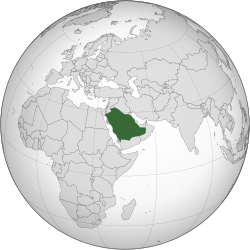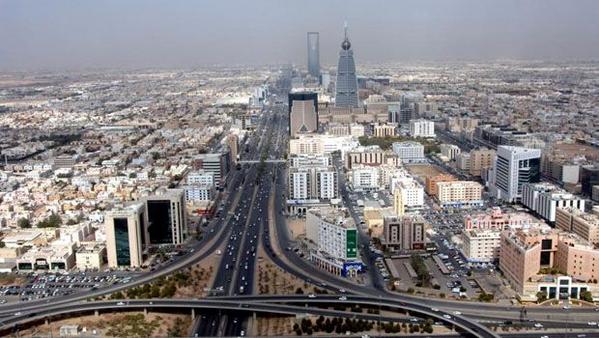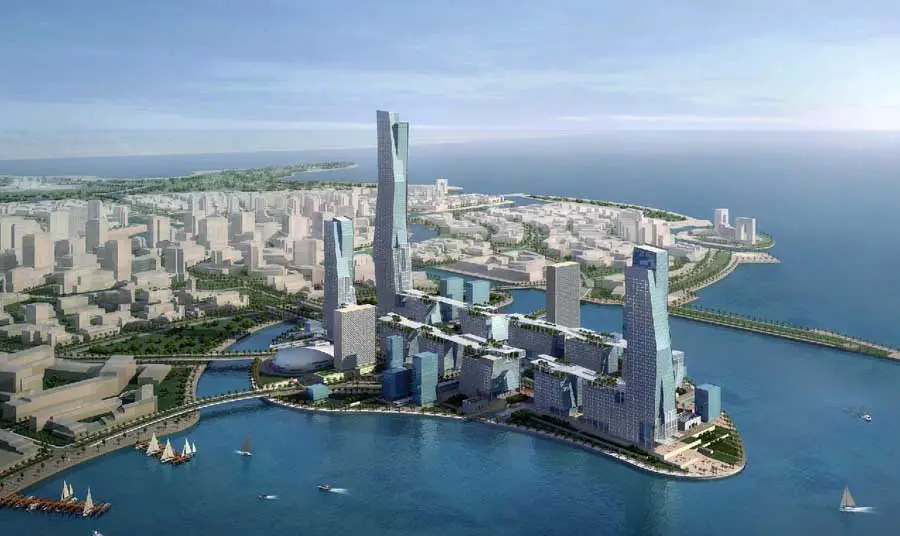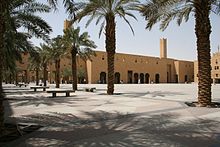
http://www.gccpo.org/DefaultEn.aspx

The Patent Office of the Cooperation Council for the Arab States of the Gulf is delighted to announce launching the electronic filing system for patent applications “Protection” in its trial version, starting from the second of August of 2014, through the office’s official website on the internet www.gccpo.org.
The “Protection” system launch comes within the frame of the office’s comprehensi…More
The GCC Patent Office (GCCPO) is a regional patent office based in Riyadh, Saudi Arabia, within the Secretariat General of the Gulf Cooperation Council (GCC). It was established in 1992 and began operations in 1998. The GCC Patent Office grants patents valid in all GCC member states. The first GCC patent was granted in 2002. As of 2013, it employed about 30 patent examiners.[1]
References
Mizael Al-Harbi, Hussam Al-Muqhim (18 April 2013). “Gulf countries: introduction to the GCC patent system”. East meets West 2013. Austria.
External links
- (Arabic) Official website
- (English) Official website
The Gulf Cooperation Council Patent Office (GCC Patent Office) is a unified patent office that serves as a convention patent office for the states of the Gulf namely, Saudi Arabia, Bahrain, Kuwait, Oman, Qatar and United Arab Emirates. The GCC Patent Office became operational in 1998. Saudi Arabia is a member of the Gulf Cooperation Council. A patent issued by the GCC Patent Office is valid and enforceable in all GCC States.
Under GCC Patent Law, it is possible to claim priority from an earlier foreign application. As compared with the Saudi Patent Office the examination process is much faster in the GCC Patent Office. Moreover, the GCC Patent Office has the following advantages:
- Filing a GCC Patent application will be more cost-effective than filing six separate national applications.. Therefore, by filing one application at the GCC Patent Office, protection is granted in all GCC States at a reduced cost.
- A Patent granted by the GCC Patent Office is valid and enforceable in all GCC States (Bahrain, Kuwait, Oman, Qatar, Saudi Arabia and U.A.E)
- The term of protection under GCC Patent Law is 20 years counted from the date of filing the patent application with the GCC Patent Office as opposed to 15 years as far as the other national patent laws are concerned.
- Duplication of registration is possible. It is possible to file a patent application in one or more of the GCC States and at the same time seek convention protection by filing at the GCC Patent Office.
- Compulsory Licensing under GCC Patent Law is now subjected to detailed conditions in conformity with the provision of the Trips Agreement.
- Importation of a patented product into GCC States will be considered as full exploitation of the invention.
- The GCC is taking the necessary steps to join Paris and PCT treaties in the near future.
- The Examination of applications is carried out by an Austrian and Australian Patent Offices.
The requirements for filing a new GCC patent application are as follows:
- Documents that must be filed along with the application:
Specifications, Claims, Drawings (if any) and Abstract of the invention in English and Arabic. - Documents that may be filed belatedly within 90 days from the filing date:
- A Power of Attorney from the applicant.
- An Extract from the Commercial Register or a certified copy of the Certificate of Incorporation of the applicant if the applicant is a corporate body.
- A Deed of Assignment, if the applicant is not the inventor.
- A Certified copy of the Priority document, if the applicant is claiming priority on the basis of a foreign application. Item Nos. 1,2 & 3 should be legalized up to any one of the GCC States Consulates.


Industrial property is one of the branches of intellectual property. It refers to the protection of rights related to the creations of the mind applied in industrial, commercial, and agricultural fields. It covers:
• Inventions
• Industrial Designs
• Plant Varieties
• Layout Designs of integrated circuits
• Trademarks
• Geographical indications of source
King Abdulaziz City for Science and Technology (KACST) grants protection documents for inventions, layout designs of integrated circuits, plant varieties and industrial designs.
History of Industrial Property in Saudi Arabia.
In 1982, KACST was notified of the Royal Decree approving the accession of Saudi Arabia to the World Intellectual Property Organization (WIPO). Accordingly, patents has been assigned to KACST since intellectual property is essentially about patents and technology transfer and KACST is the scientific body qualified for this mission.
The first Law of Patents was issued by the Royal Decree No. (M / 38) dated 10/6/1409 H (18/1/1989 AD). The Law aimed to provide protection for inventions in Saudi Arabia, and it was modified in 19 / 7 / 1425 H (4/9/2004 AD).
The modified Law of Patents, Layout Designs of Integrated Circuits, Plant Varieties, and Industrial Designs was issued by the Royal Decree No. (M/27) dated 17/7/2004 and was published in the Official Gazette (Om Alqura) in 7/8/2004, and became effective as of 5/9/2004.
Kingdom of Saudi Arabia
Al-Mamlakah al-Arabiyah as-Sa’ūdiyah

Patent Application Flowchart

Desgin Application Flowchart

Saudi Arabia has ratified the Berne Convention for the Protection of Literary and Artistic Works of 1886, revised in Paris on 24th July 1971 and the Paris Convention for the Protection of Industrial Property of 1883, both with effect from 11th March 2004. Three government authorities have authority to protect and enforce intellectual property rights: the Ministry of Commerce and Industry for trademarks, the Ministry of Culture and Information for copyright, and King Abdulaziz City for Science and Technology for patents.
Trademarks:
Trademarks are governed by the Trademarks Regulation, Royal Decree No. M/21 of 28th Jumada Awal 1423 Hejra corresponding to 8th August 2002 Gregorian, and its Implementing Rules of the same year. Applications for registration must be made to the Trademarks Office of the Ministry of Commerce and Industry which applies the ‘Nice Classification’ in accordance with the Agreement Concerning the International Classification of Goods and Services for the Purposes of the Registration of Marks of 1957.
Applications must contain the following particulars:
01. A copy of the trademark required to be registered.
02. Name, title, address, nationality and trade name of the applicant (if any). If the applicant is a juristic person, the name, address of the head office and nationality must be stated.
03. Where the application is submitted by an attorney, his name, title and address must be stated.
04. Description of the trademark required to be registered.
05. The products or services in respect of which the trademark is required to be registered, and the classification thereof.
06. Signature of the applicant or the attorney thereof.
07. Ten representations of the trademark identical to the trademark sample shown in the application for registration.
08. A copy of the power of attorney together with the original for verifying purposes must be attached where the application was submitted by an attorney of the person concerned.
09. Evidence of payment of application fees as stipulated in the Trademarks Regulation.
It is not permitted to register in Saudi Arabia, by other than its rightful owner, a trademark that is similar to an internationally known mark. Registration of a trademark allows holders protection for ten years from the date of application, renewable for similar periods. Any renewal must be specifically applied for before the end of the last year of expiry of the registration, and the procedure for renewal is the same as the one for the initial registration of the trademark. Service marks are included in the definition of trademarks. A trademark is deemed owned by the person who effects the registration. Once the registration is effected in the trademarks register, the party who has registered the trademark shall be considered the owner thereof to the exclusion of others.
A trademark can be licensed, pledged or transferred by the rightful owner. The trademark may be deleted or cancelled if it is not used for five consecutive years. Penalties for infringement of a valid trademark include imprisonment for a period of not more than one year and a fine of not less than SR50,000 and not more than SR1,000,000. Any civil or criminal disputes arising from the infringement are settled by the Board of Grievances.
Patents:
There are at present two overlapping patents systems in Saudi Arabia. The GCC Patents of Inventions Regulation of 2001, which is an amendment of an earlier statute of 1992, was approved in Saudi Arabia by Royal Decree No. M/28 of 2001. This permits the registration of patents with effect throughout the GCC countries. The GCC Patent Office is based in Riyadh.
Under Saudi Arabian law, patents are governed by the Layout Designs of Integrated Circuits, Plant Varieties, and Industrial Models Regulation, Royal Decree No. M/27 of 20th Jumada Awal 1425 Hejra corresponding to 17th July 2005 Gregorian, which gives effect to the Paris Convention for the Protection of Industrial Property under Saudi Arabian domestic law.
A protection document is granted by the General Directorate of Patents at King Abdulaziz City for Science and Technology, which gives full protection within the Kingdom to an invention, a layout design of an integrated circuit, a plant variety, or an industrial design. The protection document grants the owner the right to commercially exploit the subject matter of protection.
Applications for a protection document must be filed at the Directorate in the Arabic language, and must include:
01. Names and addresses of the applicant(s) and inventor(s);
02. Name and address of the local agent and the authorization, if the applicant resides outside the Kingdom;
03. A brief title of the subject matter of the application, an original copy and certified copies of the complete specification and certified copies of other relevant details thereof like examination and research reports;
04. Priority and disclosure information including previous filings; and
05. Evidence of payment of the filing fee at a designated bank, stipulated by the Directorate.
The protection document is the personal right of the owner and he may transfer or assign it or grant a contractual licence to others to commercially exploit the subject matter of protection. Protection is granted to the owner for a duration of 20 years for an invention, 10 years for an industrial design and a layout design of an integrated circuit, and 20 to 25 years for a new plant variety. The above periods are renewable, for an annual fee.
Copyright
The Copyright Regulation, Royal Decree No. M/41 of 2nd Rajab 1424 Hejra corresponding to 30th August 2003 Gregorian and its Implementing Rules, Resolution of the Minister of Commerce and Industry No. M/W/1788/1 of 10th Rabi Thani 1425 Hejra corresponding to 30th May 2004 Gregorian, define copyright protection to include architectural designs, speeches, theatrical, musical, photographic and cinematographic works, as well as works for radio and television, maps, video tapes and computer software. Copyright protection is not subject to any registration or renewal. The Regulation gives the author financial and moral rights, to print or publish the work, to make amendments or to delete his work, to withdraw it from circulation, and to assign it as he wishes.
In general the duration of protection afforded to different types of Copyright works is as follows:
01. The period of protection of copyright for the author of a work shall be for the duration of his life and for a period of fifty years following his death.
02. The period of protection for works where the author is a corporate entity, or if the author’s name is unknown, shall be fifty years from the date of the first publication of the work.
03. The protection period for sound works, audio-visual works, films, collective works and computer programs is fifty years from the date of the first show or publication of the work, regardless of republication.
04. The protection period for applied art (handcrafted or manufactured) and photographs shall be twenty-five years from the date of publication.
05. The protection period for broadcasting organizations shall be twenty years from the date of the first transmission of program or broadcast materials.

A special Copyright Violations Committee under the authority of the Ministry of Culture and Information presides over copyright infringement issues and it has broad powers to punish the infringer of a valid copyright including a fine of up to SR250,000 in the case of first time offenders, and this can be raised to SR500,000 if there is repeated infringement. The Committee may issue injunctions in certain cases and also order imprisonment of an offender. Any decision of the Violations Committee can be appealed by filing a claim with the Board of Grievances.
 kacst
kacst
Saudi Arabia is the largest and richest of the Gulf States. Its wealth derives mainly from its vast reserves of oil and natural gas, which places the country as the largest exporter of petroleum and give it a leading role in the Organization of the Petroleum Exporting Countries. It possesses about one-fifth of the world’s proven petroleum reserves. The Intellectual Property framework of Saudi Arabia has evolved to protect the different intellectual properly rights and to cope with the rapid globalization and technological change. Both globalization and technological advancement have presented significant economic opportunities and challenges to the IP system. As a result, IP rights have become increasingly important in the country, but many of the challenges facing the IP system have yet to be addressed.
The Patent Office in Saudi Arabia is located at the King Abdulaziz City for Science & Technology, an independent scientific organization of the Saudi Arabian Government established back in the year 1977. The Patent Office’s main activities and objectives are to:
(1) Apply the patent law and its implementing regulations: Law of Patents, Layout Designs of Integrated Circuits, Plant Varieties and Industrial Designs
(2) Grant Saudi patents, Layout Designs of Integrated Circuits, Plant Varieties and Industrial Designs
(3) Establish a Registry for the collection of local and foreign Layout Designs of Integrated Circuits, Plant Varieties and Industrial Designs
(4) Publish the Patents Gazette
(5) Encourage the inventiveness of Saudi nationals.
The Office has taken a number of measures during the past years to hire and train examiners and translators in order to adequately handle patent applications.
Legislation
Law no. 159 on the Protection of Patents, Layout Designs of Integrated Circuits, Plant Varieties and Industrial Models.
Types of Patents
– Patents of Invention
– Divisional Patents
Priority Claim
Saudi Arabia is a member of the Paris Convention. Applicants can benefit from a right of priority of 12 months to file a corresponding Saudi patent application.
Patent Cooperation Treaty
Saudi Arabia has joined the PCT but still the entry of national phase of PCT application is not possible as the relevant regulations and laws have not been issued, we expect the implementation of PCT within next 6-12 months.
Definition of an Invention
An invention must be novel, involves an inventive step and capable of industrial application. The invention may be a product, an industrial process or relates to either (Article 43).
Types of Claims
Product and process claims are acceptable. When a patent is granted for a process, any product made directly by such a process is also protected (Article 47(b)).
Exception to Protection
An invention is not patentable if it is: a discovery; a scientific theory or mathematical method; an aesthetic creation such as a literary, dramatic, or artistic work; a scheme or method for performing a mental act, games or business methods; the presentation of information; or a computer program.
Examination
– Novelty: the invention must never have been made public in any way, anywhere in the world, before the filing date or the priority date.
– Inventiveness: an invention involves an inventive step if, when compared with what is already known, it would not be obvious to someone skilled in the relevant field.
– Industrial applicability: an invention must be capable of being made or used in some kind of industry.

Novelty
Absolute novelty is required. Any act that makes an invention available to the public before the filing date or priority date has the effect of barring the invention from being patented in Saudi Arabia (Absolute Novelty). Examples of acts that can make an invention available to the public are publications, sales, public oral disclosures and public demonstrations or use, etc. However, the patent application can still be filed if disclosure was very limited and can not be cited by the examiner. Also, a one year grace period is available if the disclosure of the invention was proven to be made without the knowledge or consent of the inventor (Article 44). Wrong statement article 44 if disclosed within the priority period, but the exception is under article 30 of Implementing Regulations where the grace period is 6 months if the disclosure occurred because of abusive action.
Application Workflow
A formal examination is conducted first. If application fails to meet all the set requirements, the applicant will be notified and will be given a period of 90 days to complete the application. Once completed, the application will proceed to substantive examination. The examiner will assess the application for patentability (novelty and industrial applicability). If the claimed invention is not patentable, the applicant will be requested to present counter-arguments within 90 days from notification date. If the claimed invention is patentable, the applicant will be requested to settle the grant and publication fees. Accordingly, the letters patent will be issued and the decisions to grant the patent will be published in the Patent Official Gazette for opposition purposes.
Opposition
Oppositions may be filed within 90 days from publication date before the Board of Grievances.
Protection Term
The term of protection is 20 years from filing date.
Annuities
A maintenance fee is due annually on patents and is payable the first 3 months of each calendar year following the year the patent application was filed. There is a 3-month grace period for late payment with a surcharge.
Compulsory Licensing
A patent has to be worked. If the patent is not being fully exploited by the patentee within 4 years from the date of filing or 3 years from the date of grant, the patent will be subject to compulsory licensing under the provisions of the law.
Naming of the Inventor on the Letters Patent
Compulsory
Employer and Employee’s Rights
Employer’s Rights
The employer shall be the patentee
(1) if the invention is made in execution of a contract or a commitment for the execution of inventive efforts, unless the work contract stipulates otherwise, or
(2) if the employee would not have developed the subject matter of the protection had he not used facilities, means or data made available through his employment
Employee’s Rights
The employee has the right to receive a remuneration to be agreed upon with the consent of both parties or assessed in light of the various circumstances of the contract of employment and the economic importance of the subject matter of the protection. Any special agreement depriving the employee of this right shall be null and void.
General Provisions
A patent application filed by the employee within two years from the date of termination of employment will be considered as if submitted during employment.
All previous provisions will apply to government employees.
Patent Linkage
Requests for marketing approval of generic drugs must include details on the corresponding patent if available (filing no., filing date, and country of grant). The SFDA will then contact the Saudi Patent Office to confirm whether a patent is involved before giving marketing approval. The GCC Patent Office is not usually contacted.
Filing Requirements
1. Power of attorney, legalized up to the Saudi Consulate
2. 2 copies of the specifications in English with Arabic translation
3. 2 sets of drawings in Arabic and one in English.
4. Deed of assignment from the inventor(s), legalized up to the Saudi Consulate
5. Copy of priority document, if priority is claimed, certified.
Item 3 must be submitted at the time of filing. Document 5 must be submitted within 12 months from priority date.
Documents 1 and 4 may be submitted within 1 month from filing date.
GCC Protection
Patent protection in Saudi Arabia can also be obtained through the Gulf Cooperation Council unified patent registration system (GCC patent law of 1999).
2011 Figures
Saudi Arabia ranked first among the Arab countries in the number of patents granted for the year 2011 which amounted to 147, based on WIPO sources. It also ranked first in the number of patents filed in the same year which amounted to 78.
FAQ – Saudi Arabia (SA)
For more specific legal questions relating to the Saudi Arabian patent system, please contact International_legal_affairs@epo.org.
Questions
General information about IP in Saudi Arabia
- How to protect an invention in Saudi Arabia
- What types of industrial property rights exist in Saudi Arabia?
- How long are the terms of protection of Saudi Arabian intellectual property rights?
- When may a patent not be granted?
- What inventions cannot be patented in Saudi Arabia?
- Can computer software be patented in Saudi Arabia?
- Is Saudi Arabia a member of the Patent Cooperation Treaty (PCT)?
From filing to grant
- As a foreign applicant, do I need to appoint a professional representative in Saudi Arabia?
- What language must I use for a patent application in Saudi Arabia?
- Can I claim priority for an application filed in Saudi Arabia?
- What do I need to do to get an early filing date in Saudi Arabia?
- Does Saudi Arabia allow divisional applications?
- Do I have to file a request for examination (“deferred examination”) in Saudi Arabia?
- Can I withdraw my application before it is published in Saudi Arabia?
- Can I request that my application in Saudi Arabia be published earlier than 18 months from the filing (or earliest priority) date?
- Can I submit third-party observations on a Saudi Arabian patent application?
- What is the time limit for responding to official actions in Saudi Arabia?
After grant
- When do I have to pay annual fees in Saudi Arabia?
- Is there a grace period for paying annual fees in Saudi Arabia?
- Can a lapsed patent be restored in Saudi Arabia?
- Can I request an extension of the patent term in Saudi Arabia?
- How can I challenge a granted patent in Saudi Arabia?
Sources of information
- Where can I search Saudi Arabian patent information in English?
- Where can I find English abstracts of Saudi Arabian patent documents?
- Where can I get an English machine translation of a Saudi Arabian patent?
- Where can I find legal-status information on Saudi Arabian patents in English?
- Where can I find official information about fees in Saudi Arabia?
- Where can I find information about patent agents in Saudi Arabia?

Answers
General information about IP in Saudi Arabia
How to protect an invention in Saudi Arabia
There are two options for protecting an invention on Saudi Arabian territory:
- The first option is to file a patent application with the Saudi Arabian Patent Office. If a patent is granted, the invention will be protected only in Saudi Arabia.
- The second option is to file a patent application with the Gulf Cooperation Council (GCC) Patent Office. The GCC is a regional organisation comprising six Arab countries: the Kingdom of Saudi Arabia, Qatar, Kuwait, the United Arab Emirates, the Sultanate of Oman, and Bahrain. The GCC Patent Office is a regional office that registers patents in the member states of the GCC. Patents granted by the GCC Patent Office are valid in all GCC member states.
All the information presented below relates to the first option, protection via the Saudi Arabian Patent Office.
What types of industrial property rights exist in Saudi Arabia?
Saudi Arabia has patents, plant varieties, industrial designs, layout designs of integrated circuits and trade marks, but not utility models. Patents and designs can be registered at the Saudi Arabian Patent Office (official name: General Directorate of Patents at King Abdulaziz City of Science and Technology (KACST)). Trade marks can be registered at the Ministry of Commerce and Industry.
How long are the terms of protection of Saudi Arabian intellectual property rights?
The terms of protection for the different types of intellectual property are as follows:
- patents: 20 years from the date of filing
- plant varieties: 20 years
- industrial designs: 10 years
- layout designs of integrated circuits: 10 years
 riyadh
riyadh
When may a patent not be granted?
Article 4 of the Saudi Arabian Patent Law states the following:
“(a) The protection document shall not be granted if its commercial exploitation violates the Shari’ah (Islamic law).
(b) The protection document shall not be granted if its commercial exploitation is harmful to life, to human, animal or plant health, or is substantially harmful to the environment.”
What inventions cannot be patented in Saudi Arabia?
Article 45 of the Saudi Arabian Patent Law states the following:
“In the application of provisions of this Law, the following shall not be regarded as inventions:
(a) Discoveries, scientific theories and mathematical methods.
(b) Schemes, rules and methods of conducting commercial activities, exercising pure mental activities or playing a game.
(c) Plants, animals and processes – which are mostly biological – used for the production of plants or animals, with the exception of micro-organisms, non-biological and microbiology processes.
(d) Methods of surgical or therapeutic treatment of human or animal body and methods of diagnosis applied to human or animal bodies, with the exception of products used in any of these methods.”
The exclusion also applies to computer programs and any other copyright work.
Can computer software be patented in Saudi Arabia?
Computer programs as such are not patentable, but may be protected by copyright. Computer-related inventions may be patentable in Saudi Arabia if the requirements for patentability are met.
Is Saudi Arabia a member of the Patent Cooperation Treaty (PCT)?
As of 3 August 2013, Saudi Arabia will be bound by the PCT. From that date onwards, nationals and residents of Saudi Arabia will be entitled to file international applications under the PCT.
From filing to grant
As a foreign applicant, do I need to appoint a professional representative in Saudi Arabia?
All non-residents wishing to apply for a patent require an authorised Saudi Arabian representative. Applicants have to file a power of attorney which has been duly notarised and legalised by the consulate of Saudi Arabia.
More information:
What language must I use for a patent application in Saudi Arabia?
Documents submitted under the Saudi Arabian Law of Patents must be in Arabic.
Can I claim priority for an application filed in Saudi Arabia?
Yes, the priority term is 12 months from the earliest claimed priority, as stipulated in the Paris Convention. Saudi Arabia has been a member of the Paris Convention since 2004.
What do I need to do to get an early filing date in Saudi Arabia?
Does Saudi Arabia allow divisional applications?
Yes. Where an application contains two or more inventions, applicants may submit a divisional application on their own initiative any time before the decision to grant or reject the application.

Do I have to file a request for examination (“deferred examination”) in Saudi Arabia?
You do not need to file a request for examination. Applications are examined automatically, on the basis of the filing date. It is possible to withdraw applications.
Can I withdraw my application before it is published in Saudi Arabia?
Yes, you can withdraw an application before it is published.
Can I request that my application in Saudi Arabia be published earlier than 18 months from the filing (or earliest priority) date?
No, it is not possible to request early publication of an application.
Can I submit third-party observations on a Saudi Arabian patent application?
No, it is not possible to submit third-party observations.
 King Abdullah Economic City
King Abdullah Economic City
What is the time limit for responding to official actions in Saudi Arabia?
Responses to official actions should be submitted within 90 days from the date of the action.
After grant
When do I have to pay annual fees in Saudi Arabia?
Annual fees are due at the beginning of each year (1 January until 30 March), starting from the year following the filing date.
Is there a grace period for paying annual fees in Saudi Arabia?
Applicants or patent holders who fail to pay within a maximum period of three months from the due date are liable to pay double the amount of the fee. If they fail to pay after being warned during the three months following the expiration of the first three months, the patent will cease to be valid and this will be recorded in the Register and published in the Gazette.
Can a lapsed patent be restored in Saudi Arabia?
In case of force majeure it is possible to have a lapsed patent restored at the Saudi Arabian Patent Office.
 Makkah in Saudi Arabia
Makkah in Saudi ArabiaCan I request an extension of the patent term in Saudi Arabia?
No. In Saudi Arabia the 20-year term for patents cannot be extended. The Saudi Arabian Patent Law does not include any provisions on patent term extensions or supplementary protection certificates (SPCs).
How can I challenge a granted patent in Saudi Arabia?
Within 90 days from publication of the decision to grant, any interested party may apply for partial or total revocation of the patent.
Invalidation is possible for a third party at any time after grant and must be raised before a separate governmental body (Appeals Committee).
Sources of information
Where can I search Saudi Arabian patent information in English?
The Saudi Arabian Patent Office has an English-language database known as “IP search”. On this platform you can perform searches according to dates, numbers or applicant/inventor names.
If you require a more detailed answer, please send us your question using the contact form.
Where can I find English abstracts of Saudi Arabian patent documents?
In general, the Saudi Arabian Patent Office does not produce any English abstracts for its patent documents. Where a non-Saudi Arabian applicant files an application, the abstract may also be in English (and in Arabic), while the rest of the patent has to be in Arabic only. Therefore, English abstracts are also available in certain circumstances.
Where can I get an English machine translation of a Saudi Arabian patent?
There are no machine translations of Saudi Arabian patents available yet.
Where can I find legal-status information on Saudi Arabian patents in English?
In general, legal-status information for Saudi Arabian patents is not yet available, but a brief “application status” can be found together with the bibliographic information in the “IP search” database.
Where can I find official information about fees in Saudi Arabia?
Information about fees is currently available in Arabic only.
Where can I find information about patent agents in Saudi Arabia?
The KACST website gives detailed information about the role of patent attorneys and the services they provide. It is available in Arabic only.
If you require a more detailed answer, please send us your question using the contact form.
























